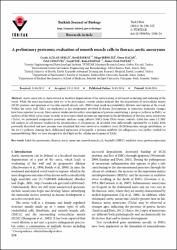| dc.contributor.author | Açılan Ayhan, Ceyda | |
| dc.contributor.author | Baykal, Betül | |
| dc.contributor.author | Serhatlı, Müge | |
| dc.contributor.author | Kaçar, Ömer | |
| dc.contributor.author | Adıgüzel, Zelal | |
| dc.contributor.author | Taş, Serpil | |
| dc.contributor.author | Baysal, Kemal | |
| dc.contributor.author | Baykal, Ahmet Tarık | |
| dc.date.accessioned | 10.07.201910:49:13 | |
| dc.date.accessioned | 2019-07-10T20:03:40Z | |
| dc.date.available | 10.07.201910:49:13 | |
| dc.date.available | 2019-07-10T20:03:40Z | |
| dc.date.issued | 2014 | en_US |
| dc.identifier.citation | Açılan Ayhan, C., Baykal, B., Serhatlı, M., Kaçar, Ö., Adıgüzel, Z., Taş, S. ... Baykal, A. T. (2014). A preliminary proteomic evaluation of smooth muscle cells in thoracic aortic aneurysms. Turkish Journal of Biology, 38(2), 238-252. https://dx.doi.org/10.3906/biy-1306-24 | en_US |
| dc.identifier.issn | 1300-0152 | |
| dc.identifier.issn | 1303-6092 | |
| dc.identifier.uri | https://dx.doi.org/10.3906/biy-1306-24 | |
| dc.identifier.uri | https://hdl.handle.net/20.500.12511/3920 | |
| dc.description | WOS: 000332944300010 | en_US |
| dc.description.abstract | Aortic aneurysm is characterized as localized degeneration of the aorta leading to advanced weakening and widening of the vessel. While the exact mechanisms have yet to be determined, current studies indicate that the degradation of extracellular matrix (ECM) proteins and apoptosis of vascular smooth muscle cells (SMCs) may result in extendibility, dilation, and rupture of the vessel. Within the aortic wall, SMCs are implicated as key components involved in disease development, as numerous molecular changes have been reported to occur. Most current studies involve either investigation of proteins constituting a group or pathway in SMCs, or analyses of the whole aortic tissue. In order to determine which proteins are important in the development of thoracic aortic aneurysms (TAAs), we performed comparative proteomic analyses using cultured SMCs from TAAs versus controls. Label-free nano LC-MS/MS analysis of cell extracts resulted in the identification of 256 proteins, 26 of which were differentially regulated by >= 1.4-fold. Both previously described and new proteins were identified that were involved in oxidative stress, ECM formation, energy metabolism, or the 14-3-3 pathway. Among these, differential expression of SerpinH1, a protease inhibitor for collagenases, was further verified via immunoblotting. Here we have attempted to shed light on the cellular mechanisms of TAAs. | en_US |
| dc.description.sponsorship | European Union [200647] | en_US |
| dc.description.sponsorship | This work was supported by the European Union 7th Framework Programme Project entitled Fighting Aneurysmal Disease (FAD), Health-2007-2.4.2-2, Grant Agreement No. 200647, and internal funding through TUBITAK. | en_US |
| dc.description.sponsorship | Türkiye Bilimsel ve Teknolojik Araştırma Kurumu (TÜBİTAK) | en_US |
| dc.language.iso | eng | en_US |
| dc.publisher | The Scientific and Technological Research Council of Turkey | en_US |
| dc.rights | info:eu-repo/semantics/openAccess | en_US |
| dc.subject | Label-Free Proteomics | en_US |
| dc.subject | Thoracic Aortic Aneurysm | en_US |
| dc.subject | Smooth Muscle Cell | en_US |
| dc.subject | SerpinH1/HSP47 | en_US |
| dc.subject | Oxidative Stress | en_US |
| dc.subject | Protein Expression | en_US |
| dc.title | A preliminary proteomic evaluation of smooth muscle cells in thoracic aortic aneurysms | en_US |
| dc.type | article | en_US |
| dc.relation.ispartof | Turkish Journal of Biology | en_US |
| dc.department | İstanbul Medipol Üniversitesi, Tıp Fakültesi, Temel Tıp Bilimleri Bölümü, Tıbbi Biyokimya Ana Bilim Dalı | en_US |
| dc.authorid | 0000-0002-8814-7351 | en_US |
| dc.identifier.volume | 38 | en_US |
| dc.identifier.issue | 2 | en_US |
| dc.identifier.startpage | 238 | en_US |
| dc.identifier.endpage | 252 | en_US |
| dc.relation.ec | info:eu-repo/grantAgreement/EC/FP7/200647 | en_US |
| dc.relation.publicationcategory | Makale - Uluslararası Hakemli Dergi - Kurum Öğretim Elemanı | en_US |
| dc.identifier.doi | 10.3906/biy-1306-24 | en_US |
| dc.identifier.wosquality | Q3 | en_US |
| dc.identifier.scopusquality | Q2 | en_US |


















